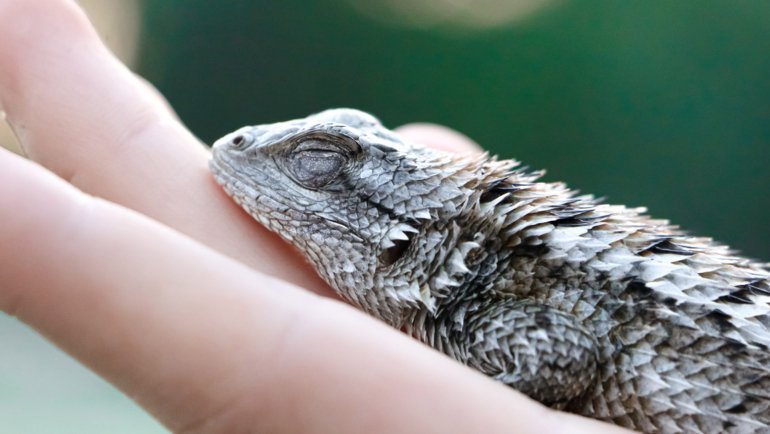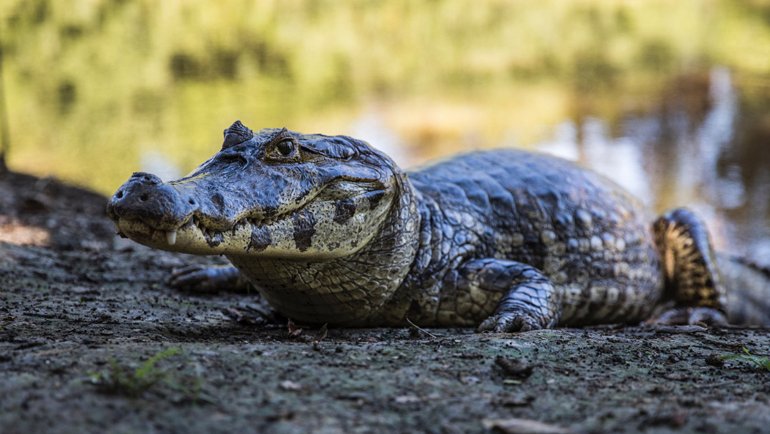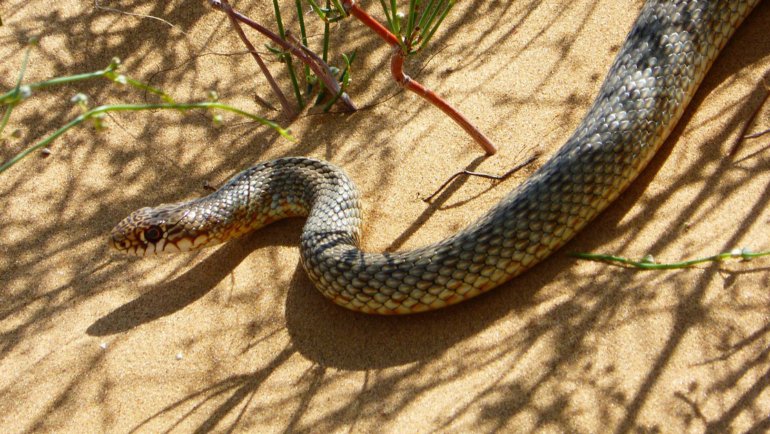The anaconda is undoubtedly one of the most impressive snakes on the planet. With its impressive size – the green anaconda being the largest by weight and the second-longest – these serpents dominate their habitats in South America, primarily in the vast wetlands and dense rainforests.
Their bodies, which can stretch to lengths exceeding 30 feet in some cases, are not built for chasing down fast-moving prey like many smaller, slender snakes. But what they lack in speed, they make up for in power and stealth. Speed, while not their foremost asset, plays a crucial role in their survival, especially in how they navigate their environments and capture prey.
Anaconda Speed on Land
On land, the sheer bulk of an anaconda prevents it from reaching the speeds seen in smaller, more agile snakes. In a terrestrial setting, an anaconda typically moves at a pace of approximately 1 mile per hour (mph) / 1.6 km/h.
Their movement can be described as a ‘serpentine crawl’, a lateral undulating movement where the snake contracts its muscles in sequences to push off irregularities in the ground, propelling itself forward.
Factors Influencing Their Speed
Several factors influence their terrestrial speed.
- First and foremost is the terrain. In dense rainforests with a thick understory, their movement might be slightly hampered by the myriad obstacles in their path.
- Size also plays a significant role; younger, smaller anacondas can move faster and more fluidly on land compared to their bulkier, mature counterparts.
- Body temperature is another crucial determinant. Being ectothermic (or cold-blooded), an anaconda’s body temperature is influenced by its surroundings. During cooler periods, the snake may be sluggish and lethargic, reducing its speed. Conversely, when they’ve warmed up adequately, usually by basking in sunlight or lying on warm ground, their muscle activity and metabolic processes increase, allowing for faster and more efficient movement.
In essence, while anacondas are not the speedsters of the snake world on land, they have evolved to be effective hunters, relying more on their stealth, power, and patience rather than swift pursuit.
 Source: Wikimedia Commons
Source: Wikimedia CommonsAnaconda Speed in The Water
While the anaconda might seem sluggish on land, water is its true domain. When submerged, this mighty serpent transforms into a nimble and efficient swimmer. In aquatic environments, anacondas can achieve speeds of up to 5 to 10 miles per hour (8-16 km/h) over short distances.
Their strong, muscular bodies, particularly their robust tail, act as a powerful paddle, propelling them through water with an elegant serpentine motion.
Adaptations For The Water
Several adaptations give the anaconda an edge in water.
Their eyes and nostrils are positioned on top of their heads, allowing them to remain mostly submerged while still being able to see and breathe. This not only aids in stealth but ensures they can navigate aquatic terrains with minimal resistance.
The contrast in speed between land and water is primarily due to the anaconda’s physical design. Its hefty, elongated body, which can be a hindrance on uneven terrestrial surfaces, becomes an asset in water, offering streamlined movement.
The reduced friction in water compared to the resistance of the ground allows the snake to glide with much more freedom and agility.
How Fast Are Anacondas During Hunting?
Anacondas are ambush predators, meaning they rely on stealth and strategy more than raw speed when hunting. They are masters of patience, sometimes waiting for hours or even days submerged in water or hidden in the foliage, awaiting the perfect moment to strike. Once their target is within range, they strike with astonishing swiftness, often leaving the prey with little to no time to react.
While their burst of speed during a strike is impressive, it’s relatively short-lived. The anaconda’s true strength lies in its constriction technique post-capture. Once it has ensnared its prey using its sharp, backward-curving teeth, it coils around the victim, applying immense pressure with each exhalation of the prey, eventually leading to suffocation.
During hunting, the element of surprise is more crucial for the anaconda than sustained speed. Their strategy is to remain hidden and undetected until the opportune moment, making their swift strike highly effective. This technique ensures they conserve energy while maximizing their chances of a successful hunt.
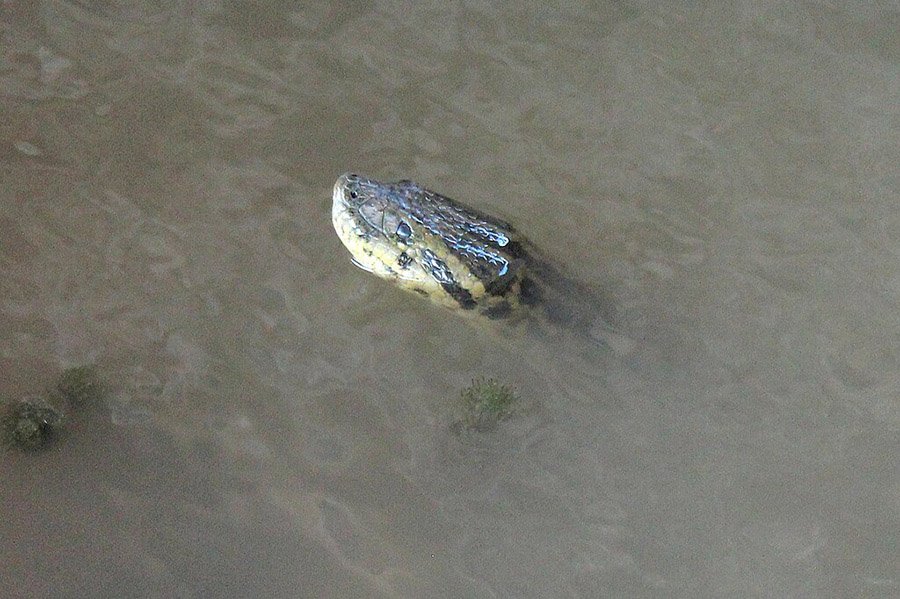 Source: Wikimedia Commons
Source: Wikimedia CommonsSpeed and Survival
While speed is a crucial survival tool for many animals, the anaconda, being the massive creature that it is, employs a different set of strategies. Due to its sheer size, the anaconda doesn’t need to be the fastest creature in the jungle or river to survive. Instead, it has evolved to maximize other abilities for both hunting and evasion.
Camouflage: One of the anaconda’s primary survival techniques is its ability to blend seamlessly into its environment. Its greenish-brown scales mimic the murky waters of its habitat and the dense vegetation of the rainforest floor. By remaining stationary and hidden, the anaconda can easily avoid potential threats and get close to unsuspecting prey.
Water: As mentioned, water is the anaconda’s primary domain, and it uses this environment to its advantage. By submerging most of its body, it can approach both prey and potential threats with a low profile, often undetected. This aquatic stealth more than compensates for its lack of blistering speed.
Constriction: The anaconda’s primary hunting method doesn’t require chasing down prey over long distances. Instead, it relies on its power to constrict and subdue its meals. Once the anaconda grabs onto a target, speed becomes irrelevant as its immense strength takes over.
In essence, for anacondas, survival is less about raw speed and more about strategic positioning, stealth, and overwhelming strength.
Comparisons with Other Snakes
The animal kingdom is vast, and when it comes to snakes, there’s a wide variance in speed. Let’s see how the anaconda measures up against other notable serpents:
Black Mamba: One of the fastest land snakes in the world, the black mamba can reach speeds of up to 12 miles per hour, making it significantly faster than an anaconda on land. Its slender, agile body allows for rapid movement, essential for both hunting and evasion in the African savannas.
Reticulated Python: Another heavyweight in the snake world, the reticulated python, native to Asia, shares many similarities with the anaconda. While it’s slightly more agile on land due to its habitat and physique, its speed is comparable to that of the anaconda, relying more on ambush techniques than chasing prey.
King Cobra: The majestic king cobra, found in the forests of Southeast Asia, is another large snake but is more agile than the anaconda. While not as fast as the black mamba, its speed combined with its venomous bite makes it a formidable predator.
The speed of a snake is heavily influenced by its size, habitat, and evolutionary needs. While the anaconda might not win any races against smaller, more agile snakes, it’s perfectly adapted to its environment and its hunting style, proving that in nature, there’s always a balance between speed, strength, and strategy.
| Snake | Speed on Land | Speed in Water |
| Green Anaconda | 1.6 km/h (1 mph) | 8 to 16 km/h (5 to 10 mph) |
| Black Mamba | 19.3 km/h (12 mph) | N/A |
| Reticulated Python | 2.4 km/h (1.5 mph) | N/A |
| King Cobra | 16 km/h (10 mph) | N/A |
The Role of Thermoregulation
Anacondas, like all reptiles, are ectothermic animals. This means they rely on external sources to regulate their body temperature. Their activity, including their speed, is directly influenced by their body temperature. In colder conditions, an anaconda’s muscles may work slower, making them less active and slower in their movements.
Conversely, when they absorb heat, they become more active, and their speed increases. This is why they are often seen basking in the sun or lurking in warmer waters, as it helps them achieve the optimal temperature for activity.
Understanding this behavior is crucial when considering the speed at which an anaconda can move, as its temperature directly impacts its muscle functionality.
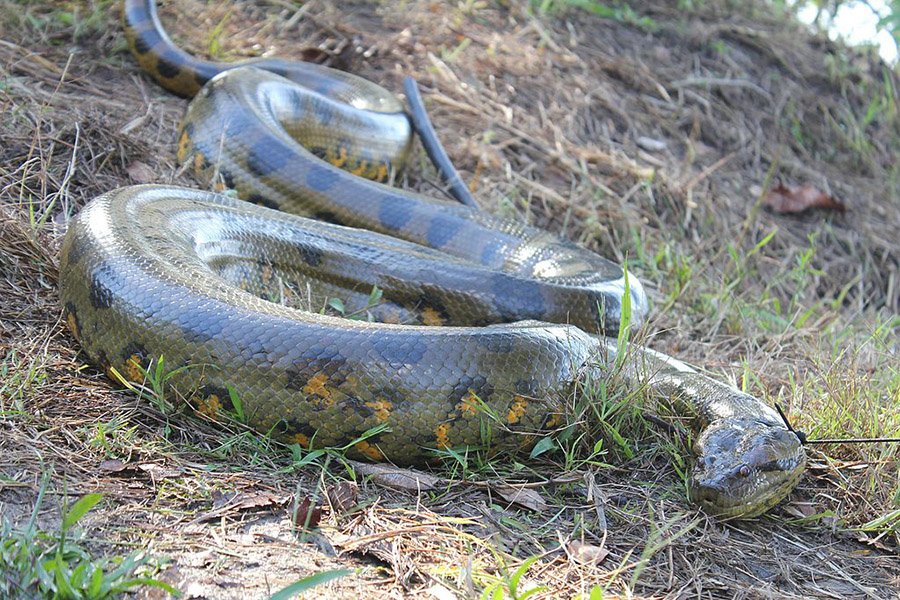 Source: Wikimedia Commons
Source: Wikimedia CommonsAnaconda Speed: Myths vs. Reality
The anaconda’s speed has been the subject of numerous myths, often fueled by movies and exaggerated tales. Hollywood depictions, particularly in thrillers or horror genres, often present the anaconda as a lightning-fast predator, capable of chasing down humans or large prey within seconds.
However, in reality, while they are efficient swimmers and have a surprising turn of speed in the water, they are not built for chasing prey over long distances on land. Their primary hunting method is ambush, using stealth and constriction rather than raw speed. It’s essential to differentiate these fictional portrayals from the actual behavior and capabilities of the anaconda.
Frequently Asked Questions
How fast can the biggest anaconda move?
Even the largest anacondas, typically Green Anacondas, move at a speed of around 1-2 km/h (0.6-1.2 mph) on land and can achieve slightly higher speeds in water, up to 3 km/h (1.8 mph).
Can an anaconda chase down a human?
While anacondas can move swiftly in short bursts, especially in water, they are not built for long chases. A healthy human can easily outpace an anaconda on land.
Do anacondas get slower as they age?
Like many animals, anacondas may exhibit reduced mobility as they age. However, their hunting strategy, primarily based on ambush, remains consistent throughout their life.
How do anacondas compare in speed to other large snakes?
Anacondas, being heavy-bodied snakes, are not as fast as some of the slender, more agile snake species. For instance, the Black Mamba, a highly venomous snake, can achieve speeds up to 16-20 km/h (10-12 mph) on land, which is considerably faster than any anaconda. However, in their aquatic habitat, anacondas exhibit impressive speed and agility.
Learn More About Anacondas
- Anaconda: Characteristics, Diet, Facts & More [Fact Sheet]
- Anaconda vs. Boa Constrictor: A Detailed Comparison
- How Long Do Anacondas Live? Anaconda Lifespan and Life Cycle Explained
- Are Anacondas Dangerous? Do They Attack Humans?
- Do Anacondas Eat People? Has It Happened Before?
- Anaconda vs. Crocodile: How Do They Compare and Who Wins in a Fight?
- Where Do Anacondas Live? Range and Preferred Habitats
- King Cobra vs. Anaconda: A Comparative Look at Two Giant Snakes

